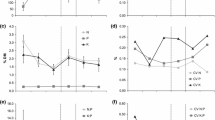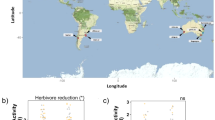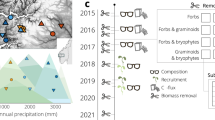Abstract
Aims
A new method, based on the latent variable measurement model, was recently developed to quantify generalised soil fertility (FG) in grassland ecosystems; i.e. the productive capacity of a soil at a multispecific scale when non-soil variables are held constant. To predict FG values, this method uses the relative growth rates (RGR) of Festuca rubra, Trifolium pratense, Triticum aestivum and Arabidopsis thaliana grown in intact soil.
We investigated three simplifications of this method; namely, (i) the use of sieved soil instead of intact cores, (ii) the use of a single measure of biomass production instead of RGR and (iii), a combination of these two modifications.
Methods
Using 26 grassland soils from southern Quebec (Canada), FG values were predicted for each method and compared using Pearson correlation coefficients. We also evaluated the performances of these different FG values, as well as measures of NO3−, P and K in predicting aerial net primary production (NPP) of the vegetation in these sites in a common non-soil environment.
Result
The four methods had comparable and very consistent FG values and, although they were not numerically equivalent, they were equivalent in predicting natural NPP of plant communities, and these predictions were better than the direct measures of NO3−, K and P flux rates as measured by Plant Root Simulator probes.
Conclusions
Therefore, any of these methods could be used to assess the generalized fertility.






Similar content being viewed by others
Abbreviations
- BLUPs:
-
best linear unbiased predictors
- BM:
-
biomass
- CWM:
-
community-weighted means
- FG :
-
generalized fertility
- LDMC:
-
leaf dry matter content
- RGR:
-
relative growth rate
- SLA:
-
specific leaf area
References
Abbott L K, Murphy D V (2007) Soil biological fertility: a key to sustainable land use in agriculture. Springer. 267p
Bates D, Maechler M, Bolker B, Walker S (2015) Fitting linear mixed-effects models using lme4. J Stat Softw 67:1–48
Daou L, Shipley B (2019) The measurement and quantification of generalized gradients of soil fertility relevant to plant community ecology. Ecology 100(1):e02549. https://doi.org/10.1002/ecy.2549
Daou L, Luglia M, Perissol C, Calvert V, Criquet S (2017) Sporulation and physiological profiles of bacterial communities of three Mediterranean soils affected by drying-rewetting or freezing-thawing cycles. Soil Biol Biochem 113:116–121
Dray S, Dufour AB (2007) The ade4 package: implementing the duality diagram for ecologists. J Stat Softw 22:1–20
Fierer N, Schimel JP (2003) A proposed mechanism for the pulse in carbon ioxide production commonly observed following the rapid rewetting of a dry soil. Soil Sci Soc Am J 67:798–805
Franzluebbers AJ (2002) Water infiltration and soil structure related to organic matter and its stratification with depth. Soil Tillage Res 66:197–205
Gelman A, Su Y-S, Yajima M, Hill J, Pittau M G, Kerman J, Zheng T, Dorie V (2007) Functions to accompany A. Gelman and J. Hill, data analysis using regression and multilevel/hierarchical models, Cambridge University Press, 2007
Grime JP (1977) Evidence for the existence of three primary strategies in plants and its relevance to ecological and evolutionary theory. Am Nat 111:1169–1194
Grime JP (2006) Trait convergence and trait divergence in herbaceous plant communities: mechanisms and consequences. J Veg Sci 17:255–260
Hattori T (1988) Soil aggregates in microhabitats of microorganisms. Reports of the Institute for Agricultural Research, Tohoku University 37:23–36
Kraft NJB, Godoy O, Levine JM (2015) Plant functional traits and the multidimensional nature of species coexistence. Proc Natl Acad Sci U S A 112:797–802
Laughlin DC, Laughlin DE (2013) Advances in modeling trait-based plant community assembly. Trends Plant Sci 18:584–593
Liu X, Swenson NG, Wright JS, Zhang L, Song K, Du Y, Zhang J, Mi X, Ren H, Ma K (2012) Covariation in plant functional traits and soil fertility within two species-rich forests. PLoS One 7(4)
Mayfield MM, Levine JM (2010) Opposing effects of competitive exclusion on the phylogenetic structure of communities. Ecol Lett 13:1085–1093
Ordoñez JC, Van Bodegom PM, Witte J-P M, Wright IJ, Reich PB, Aerts R (2009) A global study of relationships between leaf traits, climate and soil measures of nutrient fertility. Glob Ecol Biogeogr 18:137–149
R Development Core Team R: a Language and Environment for Statistical Computing 3–900051–07-0, R Foundation for Statistical Computing, Vienna, Austria (2013) URL http://www.R-project.org/
Rillig MC, Mummey DL (2006) Mycorrhizas and soil structure. New Phytol 171:41–53
Rosseel Y (2012) Lavaan: an R package for structural equation modeling. J Stat Softw 48:1–36
Shipley B (2010) From plant traits to vegetation structure. Chance and selection in the assembly of ecological communities. Cambridge Univ. Press, Cambridge
Shipley B, De Bello F, Cornelissen JHC, Laliberté E, Laughlin DC, Reich PB (2016) Reinforcing loose foundation stones in trait-based plant ecology. Oecologia 180:923–931
Six J, Feller C, Denef K, Ogle S, de Moraes SJC, Albrecht A (2002) Soil organic matter, biota and aggregation in temperate and tropical soils – effects of no-tillage. Agronomie, EDP Sciences 22:755–775
Warton DI, Shipley B, Hastie T (2014) CATS regression – a model-based approach to study trait-based community assembly. Methods Ecol Evol 6:389–398
Acknowledgements
This research was funded by the Natural Sciences and Engineering Research Council of Canada. Data will be archived in Dryad repository (http://datadryad.org). We thank Didier Labarre and Xavier Lamontagne for help in the experimental setup.
Author information
Authors and Affiliations
Corresponding author
Additional information
Responsible Editor: François Teste
Publisher’s note
Springer Nature remains neutral with regard to jurisdictional claims in published maps and institutional affiliations.
Rights and permissions
About this article
Cite this article
Daou, L., Shipley, B. Simplifying the protocol for the quantification of generalized soil fertility gradients in grassland community ecology. Plant Soil 457, 457–468 (2020). https://doi.org/10.1007/s11104-020-04729-4
Received:
Accepted:
Published:
Issue Date:
DOI: https://doi.org/10.1007/s11104-020-04729-4




